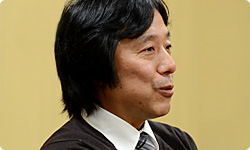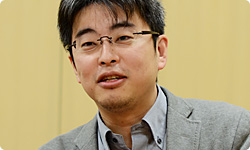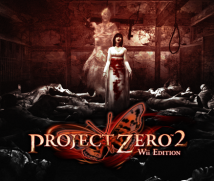4. Fear and Fun at the Haunted House
It seems that you had quite a clear idea right from the start that Project Zero 2: Wii Edition should be reborn as a new game. But I’m sure you came up against a lot of barriers during the development process. Could you tell me how you managed to overcome these barriers?
Well, as you can imagine, the first major barrier we came up against related to the issue Shibata just touched upon - changing the camera angle. It’s a game where a lot of the fear lies in the way the map is laid out, so by changing the camera angle, there’s a risk that the player might not look at something you wanted them to see, meaning the game won’t function as it’s intended to.
So changing the camera angle meant that you had to rework the game design from the ground up.
We ended up having to make a lot of changes to the map. But because all of us on the development team knew the map inside out, it made it really difficult to judge which precise points needed to be changed.
I think that’s natural. The development team have played the game countless times, so the image of the map will be seared into their minds, meaning you’ll all inevitably have certain assumptions about the way it should be.
That’s why we formed a ‘Minakawa Village Walking Society’ together with Osawa-san and Izuno-san. We would walk around the village, covering every area of the map, checking to see whether the right information was appearing at the right time, and whether the way the player was being drawn into the story was effective. The idea was to slowly, ploddingly check that all of the details were in place.
What kind of feedback came out of that ‘Walking Society’?
As well as seeing where we needed to make adjustments to the map, we also looked at the guidance the player would get at the start of the game. Osawa-san and Izuno-san gave us a lot of carefully considered feedback on the tutorial that initially introduces the player to the story.
That’s the part of the game that we often refer to in our company as the ‘first half hour’. If you fail to draw the player into the game right at the start, you will fail to get the response you wanted from the player, no matter how many great things might be in the game after that. That’s why they would have paid a lot of attention to this section. (turning to Toru Osawa, who is listening to the interview) Isn’t that right, Osawa-san?
Yes, it is. I think you need to get the player happy and comfortable with the controls and the tutorial guidance structure before trying to frighten them, otherwise it just ends up being a stressful experience, and the player won’t be able to focus on the game world. Tecmo Koei has excelled in creating the frightening elements of the game. We felt our job was to enable the player to fully appreciate this fear by leading them into the game in a way that’s as a stress-free as possible. That’s why we focused a lot on the difficulty level and the tutorial guide system.

It’s that old Nintendo obsession with the way that the player is led into the game. (laughs)
(laughter)
But when each of us has been particular about different aspects, even to the point where others can’t possibly comprehend, it can sometimes lead to unexpected innovation and interesting developments. When you look back now at what you have created through this process of large-scale revisions, how do you feel about it?
I feel that to all intents and purposes, it’s a new game! (laughs) The objective viewpoint that Nintendo brought to the project meant that we ended up reworking a lot of different elements of the game from first principles. We’ve made significant changes to the battle system, and we have added new episodes and several endings. We’ve also brought the graphics up to date, and packed it full of features that put it right at the cutting edge of horror games. As Shibata likes to put it, “It’s got it all.”
Can you tell me precisely what you mean when you say, “It’s got it all”?
Well, I mean that we’ve included everything we wanted to when we created the original title, but have also added extra dimensions in terms of how frightening it is, how fun it is, and how challenging it is. So what I mean is that we’ve done all we could possibly do. It’s not a simple remake of the original. We’ve included new elements, such as the ‘Haunted House Mode’, which makes it feel like an all-new horror game.
Could you tell me a bit more about this ‘Haunted House Mode’?
Well, as the name suggests, it’s a mode which is ideal for a quick, no-frills game, and is great for playing with friends and family who prefer to avoid the really scary stuff. There are a number of different courses in which scary events take place, basically at random.

I had a chance to spend a little time playing this mode, and I thought you’d really put a lot of effort into making the controls and system easy to grasp, even for players without any gaming skills.
You press a button to walk, and release it to stop. You use the Wii Remote to look around. That’s it. The controls are very simple.
Osawa-san and Izuno-san really seemed to enjoy watching me play that mode. Osawa-san, I take it you find it fun to watch people being shocked and surprised? (laughs)
That’s precisely why I wanted to include this ‘Haunted House Mode’. I wanted a mode where you could watch people getting scared, and they could see you being scared in turn. This relates to something I’ve always felt - that when I’m by myself and see something frightening, I have to think in my mind, “I’m really scared!” I feel that I am missing something, like some sort of funny man’s remark, which really doesn’t sit well with me. (laughs)
A ”funny man”? Like you’d find in a manzai comedy duo?
Well, when I watch a horror film, I want to watch it with someone else so I can say things like, “I never saw that coming!” or “No way!” By doing so, I want to share the feeling with others. It’s fun to say, “Hey, I saw you jump just now!” (laughs)
You want to share those emotions with someone else, don’t you? But I must say that making the events in the Haunted House randomly generated is a really bold decision. Until now, we have all been making games with the belief that, because we’re human beings making specific designs, the resulting experiences are fun for the players. As such, I’d be pretty dubious as to whether having events generated randomly was going to work in the first place.
We felt the same at the start, and our initial intention was that you could create and edit the maps yourself. But the problem was that if you’d tried a course once, it wouldn’t be much fun any more. Back then, you’d play a course and your response would be somewhat lukewarm, saying, “Ah... Okay... I see...”
Well, I wasn’t left wondering whether or not a ghost would appear. I could tell to a certain extent when they were about to appear. I remember saying, “It’s no good if the only fun bits are the parts you’ve had to make yourself.”
And the players who had managed to create the map couldn’t receive their due reward, or a sense of accomplishment.
We realised that it was going to be tough to proceed like this, so we reconsidered the whole idea. After a lot of twists and turns, we finally arrived at the decision to make the events in the Haunted House randomly generated. When we did that, the timing of the individual events was something we would never have come up with. We would be left saying things like, “That could never happen! That’s just really weird!” There would be a mixture of fear and laughter, when you just don’t know whether you’re finding the experience funny or terrifying. It’s a really curious feeling.
So even though you’re frightened, you find yourself laughing. (laughs)
That’s right! (laughs)
There was a lot of excitement when we were testing it out. There was a time when a ghost we couldn’t recall having made popped up in the most unlikely place.
This ghost’s disembodied head came crawling along the floor. It was actually an error in the program designating how and when ghosts should appear. We were saying, “Hold on! Did we actually make this?” “This is an error, isn’t it? We need to correct it.” Then someone else would say: “No, no. We should use this!” (laughs)
(laughs) It can be incredibly valuable when the unexpected happens.
Yes, that’s right. We were really taken aback by that. An unexpected event took place because of a data error, and we decided to keep it because it really worked. That kind of loose approach really reminded me of the good old days of the Famicom.
